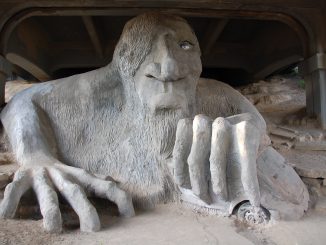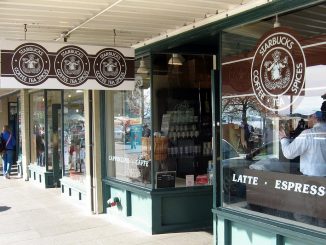
For some strange reason, a 16 foot tall bronze statue of communist leader Vladimir Lenin stands for all to see in Seattle, Washington. The work by Bulgarian sculptor Emil Venkov was completed in 1988 for display in what was then communist controlled Czechoslovakia. The statue was displayed for one year before the Velvet Revolution of 1989 and by 1993 was laying in a scrapyard, slowly decaying, much like the memory of Soviet era communism.
The Lenin bronze was purchased in 1993 by Lewis E. Carpenter, an American intent on displaying it but he passed away before his plans could come to fruition. Carpenter’s interest in buying the statue was to preserve for future generations both for its historic importance as well as its intrinsic artistic merit. He intended to use it to attract customers for an ethnic Slovak restaurant he wanted to open in Issaquah. Carpenter claimed that despite its unpopularity, it was an incredible work of art and worth preserving. After a series of public debates on appropriateness, the city rejected his permit to display the work.
Though it has become a Fremont landmark and attraction, the statue has actually been held in trust since 1995 and is technically on temporary display. The Carpenter family continues to seek a buyer for the statue. As of 2015 the asking price was US$250,000, up from a 1996 price of US$150,000 (equivalent to US$240,000 in 2018).
There have been several protests and calls for the statue to be removed but there are a few hurdles preventing that from happening. One of the hurdles is that there are in fact a lot of people that like the statue for its artistic value. Another, possibly more difficult to overcome is that the Lenin Bronze is technically on private property. The statue is not owned by the city or the state, and there are no regulations that prevent it from standing right where it is.
Sculptor Emil Venkov became known for creating artwork with distinctive subtext and the Lenin is a perfect example of his work. While most statues of the communist leader depict him as a bringer of revolution and philosopher, Venkov’s is more critical and shows him as a violent man. With the inclusion of rifles at his feet and flames slowly climbing the base, this statue is in sharp contrast to the traditional depiction of Lenin standing stoically with a book. He died at age 79 in June of 2017, and was honored by the Association of Slovak Artists. They noted that he had been instrumental in defining Slovak architectural sculpture.
Fremont Lenin Facts
- The Lenin Bronze was constructed by Emil Venkov (1937–2017), a Bulgarian sculptor under a 1981 commission from the Communist Party of Czechoslovakia.
- Carpenter financed the $40,000 purchase and moving of the bronze by mortgaging his home.
- When the statue was found in the scrapyard there was a homeless man living inside.
- In order to move the statue, it was cut into three pieces.
- The BBC highlighted the statue after protesters removed and destroyed Lenin statues in the Ukraine.
- The Fremont neighborhood’s motto is Libertas Quirkas — freedom to be peculiar.
- The statue is just a few short blocks west of The Fremont Troll, another well known roadside attraction that lives under the Aurora Bridge.
- Just before it was purchased, the statue was waiting patiently to be chopped up and sold as scrap for the price of the bronze.
- The original cost of the statue production and display was 334,0000 Kč.
Decorating the Statue
A glowing Soviet-style red star or Christmas lights have been added to the statue during the holiday season since 2004. For the 2004 Solstice Parade, the statue was made to look like John Lennon. During Gay Pride Week, the statue is dressed in drag. The statue’s hands are often painted red to protest what critics perceive as the glorification of a villain with the blood of so many on his hands.
While it may seem odd to decorate a statue based on a communist leader, it’s something of a tradition in Seattle to add festive adornments throughout the year to many sculptures around the city.


